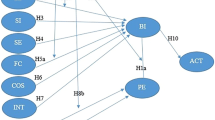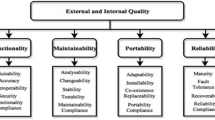Abstract
The number of open source software (OSS) users has increased in recent years. No longer are they limited to technically adept software developers. Many believe that the OSS market share could increase tremendously provided OSS had systems that were easier to use. Although examples of good usable open source software exist, it is agreed that OSS can be made more usable. This study presents an empirical investigation into the impact of some key factors on OSS usability from the end users’ point of view. The research model studies and establishes the relationship between the key usability factors from the users’ perspective and OSS usability. A data set of 102 OSS users from 13 open source projects of various sizes was used to study the research model. The results of this study provide empirical evidence by indicating that the highlighted key factors play a significant role in improving OSS usability.






Similar content being viewed by others
References
Raymond ES (1999) The cathedral and the bazaar. O’Reilly, Sebastopol
von Krogh G, Spaeth S (2007) The open source software phenomenon: characteristics that promote research. J Strateg Inform Syst 16(3):236–253
Levesque M (2004) Fundamental issues with open source software development. First Monday 9(4)
Polancic G, Horvat RV, Rozman T (2004) Comparative assessment of open source software using easy accessible data. In: Proceedings of the 26th International Conference on Information Technology Interfaces, ITI 2004 (IEEE Cat. No.04EX794), vol 1, pp 673–8
Paulson JW, Succi G, Eberlein A (2004) An empirical study of open-source and closed-source software products. IEEE Trans Softw Eng 30(4):246–256
Nichols DM, Twidale MB (2005) The usability of open source software. First Monday 8(1). http://firstmonday.org/issues/issue81/nichols/
Hedberg H, Iivari N, Rajanen M, Harjumaa L (2007) Assuring quality and usability in open source software development. In: Proceedings of the first international workshop on emerging trends in floss research and development, FLOSS. IEEE Computer Society, Washington, DC, pp 20–26
Çetin G, Göktürk M (2008) A measurement based framework for assessment of usability-centricness of open source software projects. In: Proceedings of IEEE international conference on signal image technology and internet based systems, SITIS ‘08
Porter A, Yilmaz C, Memon AM, Krishna AS, Schmidt DC, Gokhale A (2006) Techniques and processes for improving the quality and performance of open-source software. Softw Process Improv Pract 11(2):163–176
Yang J, Wang J (2008) Review on free and open source software. In: Proceedings of the 2008 IEEE international conference on service operations and logistics, and informatics (SOLI), pp 1044–1049
Stol KJ, Babar MA, Russo B, Fitzgerald B (2009) The use of empirical methods in open source software research: facts, trends and future directions. In: 2009 ICSE workshop on emerging trends in free/libre/open source software research and development (FLOSS 2009), pp 19–24
Ferenc R, Siket I, Gyimothy T (2004) Extracting facts from open source software. In: Proceedings of the 20th IEEE international conference on software maintenance, pp 60–69
Hedgebeth D (2007) Gaining competitive advantage in a knowledge-based economy through the utilization of open source software. VINE J Inform Knowl Manag Syst 37(3):284–294
Golden E, John BE, Bass L (2005) The value of a usability-supporting architectural pattern in software architecture design: a controlled experiment. In: Proceedings of the 27th international conference on software engineering, 15–21 May, St. Louis, MO, USA
Nakagawa EY, de Sousa EPM, de Brito MK, de Faria AG, Morelli LB, Maldonado JC (2008) Software architecture relevance in open source software evolution: a case study. In: Proceedings of the 2008 IEEE 32nd international computer software and applications conference (COMPSAC), pp 1234–1239
Stamelos L, Angelis L, Oikonomou A, Bleris GL (2002) Code quality analysis in open source software development. Inform Syst J 12(1):43–60
Feller J, Fitzgerald B (2000) A Framework Analysis of the Open Source Software Development Paradigm. In: Proceedings of the 21st annual international conference on information systems, Brisbane, Queensland, Australia, pp 58–69
Koch S, Neumann C (2008) Exploring the effects of process characteristics on product quality in open source software development. J Database Manag 19(2):31–57
Gyimothy T, Ferenc R, Siket I (2005) Empirical validation of object-oriented metrics on open source software for fault prediction. IEEE Trans Softw Eng 31(10):897–910
Mansfield-Devine S (2008) Open source: does transparency lead to security? Comput Fraud Secur 9:11–13
Samoladas I, Gousios G, Spinellis D, Stamelos I (2008) The SQO-OSS quality model: measurement based open source software evaluation. In: Open source development, communities and quality—OSS 2008: 4th international conference on open source systems, pp 237–248
Golden B (2005) Making open source ready for the enterprise, the open source maturity model., Extracted from succeeding with open sourceAddison-Wesley Publishing Company, Reading
Business Readiness Rating. Business readiness rating for open source. http://www.openbrr.org
QSOS. Method for qualification and selection of open source software (qsos) version 1.6. http://www.qsos.org
Deprez JC, Alexandre S (2008) Comparing assessment methodologies for free/open source software: OpenBRR and QSOS. In: Jedlitschka A, Salo O (eds) PROFES 2008. LNCS, vol 5089, pp 189–203. Springer, Heidelberg
ISO 9241 (1997). Ergonomics requirements for office with visual display terminals (VDTs)
International Standard ISO/IEC 9126-1 (2001) Software Engineering—Product Quality—Part 1: Quality Model, 1st edn, pp 9–10
Nichols DM, Twidale MB (2006) Usability processes in open source projects. Softw Process Improv Pract 11(2):149–162
Aberdour M (2007) Achieving quality in open-source software. IEEE Softw 24(1):58–64. doi:10.1109/MS.2007.2
Sampson F (2007) Who said “usability is free”? Interactions 14(4):10–11
Twidale MB, Nichols DM (2005) Exploring usability discussions in open source development. In: Proceedings of the 38th Annual Hawaii International Conference on System Sciences, pp 198–208
Bodker M, Nielsen L, Orngreen RN (2007) Enabling user centered design processes in open source communities: usability and internationalization, HCI and culture. In: Proceedings of the Second International Conference on Usability and Internationalization, UI-HCII 2007. Held as Part of HCI International 2007, part I, pp 10–18
Zhao L, Deek FP (2006) Exploratory inspection—a learning model for improving open source software usability. In: Proceedings of the Conference on Human Factors in Computing Systems CHI ‘06, pp 1589–1594
Cetin G, Verzulli D, Frings S (2007) An analysis of involvement of HCI experts in distributed software development: practical issues”, Online Communities and Social Computing. In: Proceedings of the Second International Conference, OCSC 2007. Held as Part of HCI International 2007, pp 32–40
Shneiderman B (2000) Universal usability. Commun ACM 43(5):84–91
Viorres N, Xenofon P, Stavrakis M, Vlachogiannis E, Koutsabasis P, Darzentas J (2007) Major HCI challenges for open source software adoption and development. In: Douglas (ed) Proceedings of Schuler. OCSC 2007—Online Communities and Social Computing, Second International Conference, Beijing, China, pp 455–464
Rusu C, Rusu V, Roncagliolo S (2008) Usability practice: the appealing way to HCI. In: Proceedings of first international conference on advances in computer–human interaction, achi-2008, pp 265–270
Faulkner X, Culwin F (2000) Integrating HCI and SE. ACM SIGCSE Bull 32(3):61–64
Iivari N, Hedberg H, Kirves T (2008) Usability in company open source software context. Initial findings from an empirical case study. In: Proceedings of the 4th international conference on open source systems (co-located with the World Computer Congress), Milan
Benson C, Muller-Prove M, Mzourek J (2004) Professional usability in open source projects: GNOME, OpenOffice.org, NetBeans. In: Proceedings of the CHI ‘04 extended abstracts on human factors in computing systems, Vienna, Austria
Folmer E, Bosch J (2004) Architecting for usability: a survey. J Syst Softw 70:61–78
Cronbach LJ (1951) Coefficient alpha and the internal consistency of tests. Psychometrica 16:297–334
van de Ven AH, Ferry DL (1980) Measuring and assessing organizations. Wiley, NY
Osterhof A (2001) Classroom applications of educational measurement. Prentice Hall, NJ
Campbell DT, Fiske DW (1959) Convergent and discriminant validation by the multi-trait multi-method matrix. Psychol Bull 56:81–105
Comrey AL, Lee HB (1992) A first course on factor analysis, 2nd edn. Lawrence Erlbaum, Hillsdale
Kaiser HF (1970) A second generation little jiffy. Psychometrika 35:401–417
Kaiser HF (1960) The application of electronic computers to factor analysis. Educ Psychol Measur 20:141–151
Stevens J (1986) Applied multivariate statistics for the social sciences. Erlbaum, Hillsdale
Fornell C, Bookstein FL (1982) Two structural equation models: LISREL and PLS applied to consumer exit voice theory. J Mark Res 19:440–452
Joreskog K, Wold H (1982) Systems under indirect observation: causality, structure and prediction. North Holland, The Netherlands
Wikipedia (2010). http://en.wikipedia.org/wiki/P-value
Twidale M (2005) Silver bullet or fool’s gold: supporting usability in open source software development. In: Proceedings of the 27th international conference on software engineering
Lee SYT, Kim HW, Gupta S (2009) Measuring open source software success. Omega 37(2):426–438
Koppelman H, Van Dijk B (2006) Creating a realistic context for team projects in HCI. SIGCSE Bull 38(3):58–62
Wohlin C, Runeson P, Host M, Ohlsson MC, Regnell B, Wesslen A (2000) Experimentation in software engineering. Kluwer Academic Publishers, Norwell
Faden RR, Beauchamp TL, King NMP (1986) A history and theory of informed consent. Oxford University Press, New York
Katz J (1972) Experimentation with human beings. Russell Sage Foundation, New York
Author information
Authors and Affiliations
Corresponding author
Appendix: Key usability factors from OSS user’s point of view (measuring instrument)
Appendix: Key usability factors from OSS user’s point of view (measuring instrument)
1.1 Users’ expectations
-
1.
User interface of OSS should follow standards and norms of proprietary software to make them easy to use.
-
2.
I believe OSS is not meant for novice non-technical users.
-
3.
Formal feedback from users is missing and thus needed in an OSS environment.
-
4.
Proprietary software addresses users’ expectations and requirements better than OSS.
1.2 Usability bug reporting and fixing
-
5.
Ease of reporting errors in software would increase my level of satisfaction.
-
6.
I never report an error, so usability bug reporting does not affect me.
-
7.
For effective usability inspections, user training is required.
-
8.
Usability bugs reflect users’ expectations; therefore, they need to be fixed on priority.
1.3 Interactive help features
-
9.
I believe interactive help would increase the ease of use of open source software.
-
10.
A novice user needs only basic features of the software, so interactive help features would not have much impact.
-
11.
Users of OSS are technically sophisticated; they do not need interactive help.
-
12.
Interactive help would increase learnability of OSS.
1.4 Usability learning
-
13.
OSS developers must learn how to incorporate users’ requirements and usability aspects into their software designs.
-
14.
Lack of usability knowledge is the main cause of poor usability of OSS systems.
-
15.
The realization of the fact that a software system is for end users (not for the developers themselves) is more important than the formal usability learning.
-
16.
OSS developers should use quantifiable usability metrics to measure it objectively and effectively.
1.5 Usability guidelines for OSS developers
-
17.
There should be a standardized user interface and usability guidelines that OSS developers should follow in their designs.
-
18.
Usability guidelines could act as a standard and checklist against which software could be inspected.
-
19.
Strict implementation of usability guidelines will take away the OSS developer’s freedom.
-
20.
Standardized usability guidelines are impracticable in an OSS environment.
1.6 OSS usability
-
1.
OSS with standardized usability features will help users to compare the usability of different softwares.
-
2.
Poor usability being the major hurdle, improved usable OSS systems will result in switching users from proprietary software to OSS.
-
3.
Usable software with satisfied users guarantees its success.
-
4.
Open source software having improved usability and adaptability for less technical and novice users will end up benefiting all users.
Rights and permissions
About this article
Cite this article
Raza, A., Capretz, L.F. & Ahmed, F. Users’ perception of open source usability: an empirical study. Engineering with Computers 28, 109–121 (2012). https://doi.org/10.1007/s00366-011-0222-1
Received:
Accepted:
Published:
Issue Date:
DOI: https://doi.org/10.1007/s00366-011-0222-1




